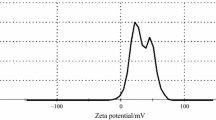Abstract
Experimental investigations were carried out to determine the convective heat transfer performance and pressure drop of Al2O3/water and SiO2/water nanofluids flowing through a circular tube. Measurements show that the addition of small amounts of nano-sized Al2O3 particles to the base fluid increases heat transfer coefficients considerably, while the result for the silica nanofluids contradicts with the alumina nanofluids and this leads to some interesting results. In the case of alumina nanofluids, an average increase of 16% in convective heat transfer coefficient is observed with an average penalty of 28% in pressure drop. Moreover, flow resistance increases significantly compared to the base fluid even at very low concentrations of nanofluids. Finally, measured heat transfer coefficients are compared with predicted ones from the correlation of Shah under the same conditions.
Similar content being viewed by others
References
WEBB T L, KIM N H. Principles of enhanced heat transfer [M]. New York: Taylor and Francis, 2005: 3–10.
CHOI S U S, EASTMAN J A. Enhancing thermal conductivity of fluids with nanoparticles [C]// ASME International Mechanical Engineering Congress & Exposition. San Francisco, 1995: 99–106.
DING Y, ALIAS H, WEN D, WILLIAMS R A. Heat transfer of aqueous suspensions of carbon nanotubes CNT nanofluids [J]. Int J Heat Mass Transfer, 2006, 49(11): 240–250.
HE Y, JIN Y, CHEN H, DING Y, CANG D, LU H. Heat transfer and flow behaviour of aqueous suspensions of TiO2 nanoparticles (nanofluids) flowing upward through a vertical pipe [J]. Int J Heat Mass Transfer, 2007, 50(11): 2272–2281.
CHEN H, YANG W, HE Y, DING Y, ZHANG L, TAN C, LAPKIN A A, BAVYKIN D V. Heat transfer and flow behaviour of aqueous suspensions of titanate nanotubes (nanofluids) [J]. Powder Technol, 2008, 183(1): 63–72.
PAK B, CHO Y. Hydrodynamic and heat transfer study of dispersed fluids with submicron metallic oxide particles [J]. Exp Heat Transfer, 1998, 11(2): 151–170.
XUAN Y, LI Q. Investigation on convective heat transfer and flow features of nanofluids [J]. J Heat Transfer, 2003, 125: 151–155.
YANG Y, ZHANG Z G, GRULKE E A, ANDERSON W B, WU G. Heat transfer properties of nanoparticle-in-fluid dispersions (nanofluids) in laminar flow [J]. Int J Heat Mass Transfer, 2005, 48(6): 1107–1116.
WEN D, DING Y. Experimental investigation into convective heat transfer of nanofluids at the entrance region under laminar flow conditions [J]. Int J Heat Mass Transfer, 2004, 47(24): 5181–5188.
KULKARNI D P, NAMBURU P K, BARGAR H E, DAS D K. Convective heat transfer and fluid dynamic characteristics of SiO2 ethylene glycol/water nanofluid [J]. Heat Transfer Engineering, 2008, 29(12): 1027–1035.
WANG X Q, MUJUMDAR A S. Heat transfer characteristics of nanofluids: A review[J]. International Journal of Thermal Sciences, 2007, 46(1): 1–19.
YU W, CHOI S U S. The role of interfational layers in the enhanced thermal conductivity of nanofluids: A renovated Maxwell model [J]. Journal on Nanoparticle Research, 2003, 5: 167–171.
BECKWITH T G, MARANGONI R D, LIENHARD J H. Mechanical measurements [M]. 5th ed. New York: Addison-Wesley Publishing Company, 1990: 282–285.
SHAH R K. Thermal entry length solutions for the circular tube and parallel plates [C]// Proceedings of 3rd National Heat and Mass Transfer Conference. Bombay, 1975: 11–75.
CELATA G P, CUMO M, ZUMMO G. Thermal-hydraulic characteristics of single-phase flow in capillary pipes [J]. Exp Thermal Fluids Sci, 2004, 28(2): 87–95.
GUO Z Y, LI Z X. Size effect on single-phase channel flow and heat transfer at microscale [J]. Int J Heat Fluid Flow, 2003, 24(3): 284–329.
HWANG Y J, AHN Y C, SHIN H S, LEE C G, KIM G T, PARK H S, LEE J K. Investigation on characteristics of thermal conductivity enhancement of nanofluids [J]. Current Applied Physics, 2006, 6(6): 1068–1071.
VARNIK F, RAABE D. Scaling effects in microscale fluid flows at rough solid surfaces[J]. Modelling and Simulation in Materials Science and Engineering, 2006, 14(5): 857–873.
Author information
Authors and Affiliations
Corresponding author
Rights and permissions
About this article
Cite this article
Ahmad, A., Mansour, K. & Masoud, D. An experimental comparison of water based alumina and silica nanofluids heat transfer in laminar flow regime. J. Cent. South Univ. 20, 3582–3588 (2013). https://doi.org/10.1007/s11771-013-1884-1
Received:
Accepted:
Published:
Issue Date:
DOI: https://doi.org/10.1007/s11771-013-1884-1




